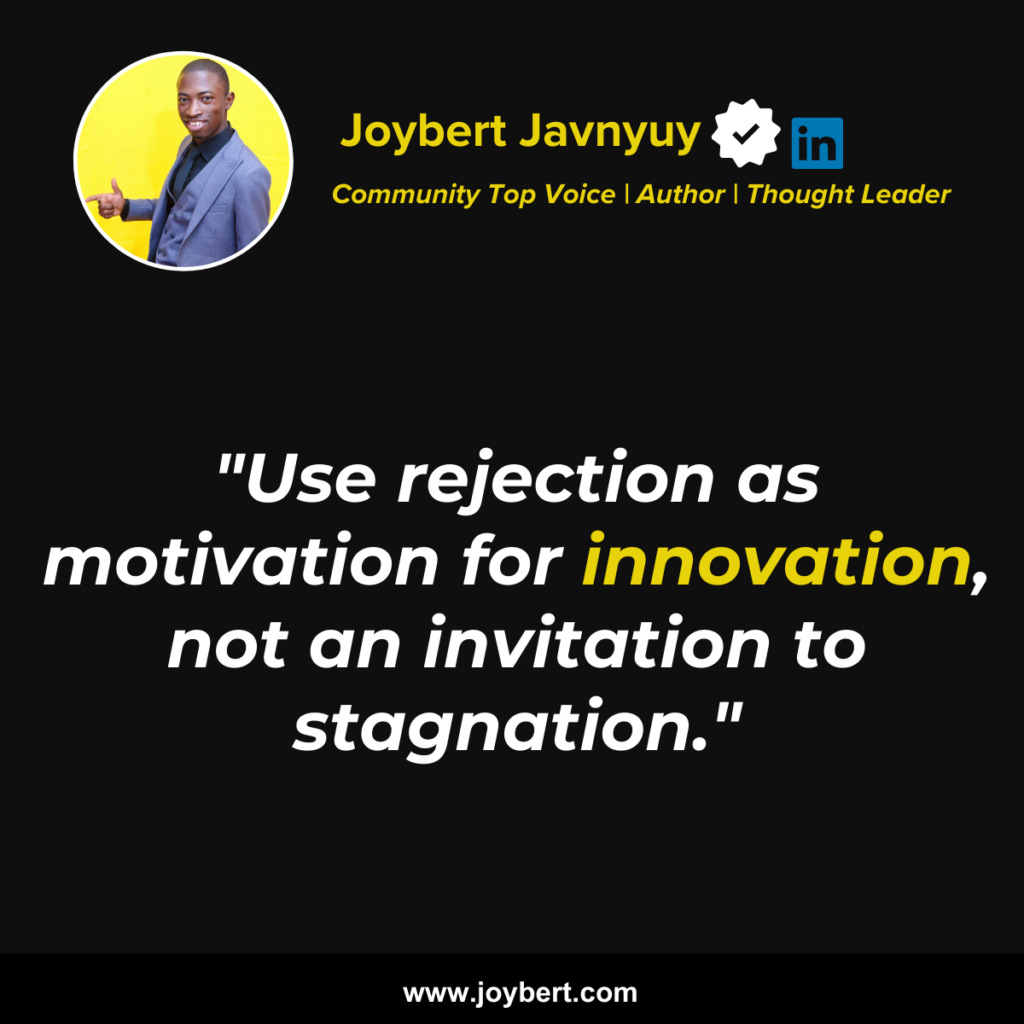A few weeks ago, I was rejected from an opportunity I was pursuing and really needed to materialize into something great. Due to the impact of this rejection, I almost decided not to try again. Then, as I was pondering, this phrase hit me: “Rejection is Not an Invitation to Stagnation.”
As an Entrepreneur and Executive, Rejection is Not an Invitation to Stagnation.

Rejection is a universal experience, especially prevalent in the entrepreneurial journey. It’s the cold email that goes unanswered, the pitch that doesn’t land, or the product launch that fails after investing your life savings. However, for a resilient entrepreneur and executive, rejection is not the end but a pivotal point for growth, innovation, and reinvention.
In the world of business, rejection can feel like a daily ritual. From the investor who doesn’t see the potential in your startup to the client who chooses your competitor, each rejection carries with it the weight of potential failure.
But herein lies the paradox of entrepreneurship: without facing rejection, growth remains a theoretical concept, not a lived experience. Did you read that statement well. Let me say it again: without facing rejection, growth remains a theoretical concept, not a lived experience.
The key to navigating the business landscape is not in avoiding rejection but in transforming it into a stepping stone for success.
Rejection in business can take many forms. It might be direct, such as a declined proposal, or indirect, like dwindling sales numbers indicating market disinterest. It’s essential to understand that rejection is not always personal nor an indicator of failure. Often, it’s a mismatch between what is offered and what is needed at a particular time or a sign that a different approach is needed. Yes, rejection can be a sign.
Here is the fact, the sting of rejection is real and can lead to self-doubt, decreased motivation, and even burnout if not properly managed. However, successful entrepreneurs learn to separate their self-worth from their business outcomes. They treat rejection as a source of feedback and a means to refine their strategies, not as a reflection of their capabilities or value.
Are you still with me? Let us proceed.
Resilience is the entrepreneur’s armor against the inevitable battles with rejection. It is the quality that allows one to bounce back stronger, wiser, and more determined.
In the entrepreneurial context, resilience is the ability to withstand and adapt to challenges, setbacks, and failures. It’s about having the mental fortitude to persevere in the face of adversity, maintaining a positive outlook, and finding innovative solutions to problems.
Building Resilience: Practical Steps
– Learning from Failure
Each failure is a lesson in disguise. Analyzing what went wrong and why helps in avoiding similar pitfalls in the future. This learning process is invaluable for personal and business growth.

– Networking and Support Systems
Building a robust network of mentors, peers, and supporters provides a safety net during tough times. These relationships offer practical advice, emotional support, and sometimes, a different perspective that can help you see the silver lining in rejection.
– Maintaining Perspective
Keeping setbacks in perspective is crucial. One rejection does not define your business or your worth as an entrepreneur. It’s essential to celebrate the small victories along the way and remember that persistence and adaptability are key to long-term success.
Strategies to Overcome Rejection
Overcoming rejection is not just about bouncing back; it’s about bouncing forward. Here are strategies to help turn rejection into a catalyst for growth.
– Reframing Your Approach to Failure
Viewing failure as part of the entrepreneurial process can change how you respond to rejection. Instead of seeing it as a setback, consider it a necessary step towards finding the right path for your business.
– Innovation as a Response to Rejection
Rejection often highlights the need for a pivot or innovation. Whether it’s tweaking your product based on customer feedback or overhauling your business model, use rejection as an impetus for creative problem-solving.
– Seeking Feedback and Acting on It
After facing rejection, seek constructive feedback from those who turned you down. This insight can be gold, offering direct pointers on what can be improved or changed for better outcomes in the future.
– Pivoting Your Business Strategy
Sometimes, consistent rejection is a sign that a more significant change is needed. Be open to pivoting your strategy or even reimagining your business if it means moving closer to your goals.
Lessons Learned and Strategies Applied
The common thread among these success stories is the refusal to see rejection as a final verdict. Instead, these entrepreneurs used rejection as feedback, an opportunity to refine their visions, and proof that their journey wasn’t over. The key takeaways include:
This article will not be complete if I do not talk about growth mindset. Why? You may be asking.
At the core of bouncing back from rejection is the concept of a growth mindset — a belief that abilities and intelligence can be developed through dedication and hard work.
What is a Growth Mindset?
A growth mindset, a term coined by psychologist Carol Dweck, describes the underlying beliefs people have about learning and intelligence. When entrepreneurs adopt a growth mindset, they embrace challenges, persist through obstacles, learn from criticism, and find lessons and inspiration in the success of others.
How to Cultivate a Growth Mindset in Your Team
Fostering a growth mindset within a team begins with leadership. Here are practical steps to encourage this perspective:
– Encourage learning from failures as much as from successes.
– Promote a culture of feedback where constructive criticism is viewed as a tool for improvement.
– Set challenges as learning opportunities and celebrate the effort, not just the outcome.
Rejection, though an unwelcome guest in the entrepreneurial journey, is an integral part of the path to success. It tests resilience, fosters innovation, and, most importantly, teaches invaluable lessons that success alone could never impart. Rejection will teach you lessons no book or coach can teach you.
Embracing rejection as an opportunity for growth, rather than a blockade to progress, sets the foundation for a resilient, innovative, and successful entrepreneurial venture.

Some questions you should ask yourself:
1. How do I differentiate between constructive and non-constructive rejection?
Constructive rejection often comes with feedback or reasons, providing insight into how to improve. Non-constructive rejection might lack explanation but can still serve as an impetus to reevaluate and refine your approach.
2. Can rejection actually benefit my business in the long term?
Absolutely. Rejection forces you to question, reevaluate, and improve your business model, product, or approach, leading to stronger strategies and offerings.
3. How can I maintain motivation in the face of repeated rejection?
Focus on learning from each rejection, seek support from mentors and peers, and celebrate the small victories. Remember, resilience builds over time and with experience.
4. Is there a point at which I should take repeated rejections as a sign to give up?
Rather than viewing it as giving up, consider whether repeated rejections indicate a need to pivot or significantly change your approach. It’s about finding the right path, which sometimes requires major adjustments.
Blessings!
Dr. Javnyuy Joybert










